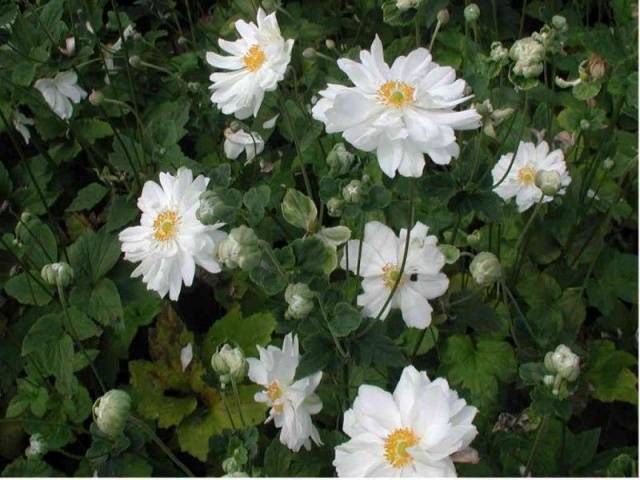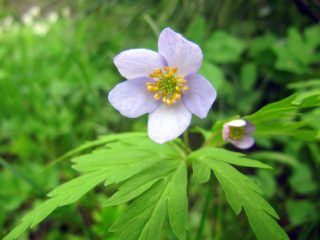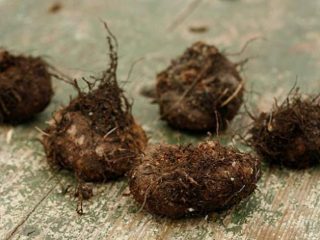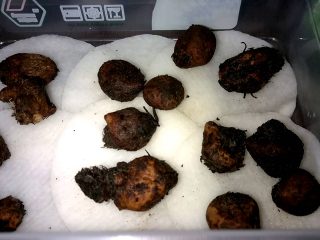Content
From late summer or early autumn, Japanese anemone begins to bloom in our gardens. This exquisite herbaceous plant is nothing like the showy crown anemone or the modest but elegant forest primrose. Japanese autumn anemone undemanding to care and grows quickly. It belongs to the genus Anemone, which contains more than 150 species, and through it is included in the vast family Ranunculaceae, widespread throughout the Northern Hemisphere except in the tropics.
Description of autumn anemone
Anemones that bloom in autumn differ from other varieties in their high growth, up to 1.5 m, and the buds collected in loose umbrellas. Their rhizomes are creeping, the leaves are large, pinnately dissected. The flowers are small, chamomile-like, and in varieties or hybrids they can be semi-double. The color of the petals is all shades of white and pink, the stamens and center are yellow or light green. There are varieties and hybrids of Japanese anemone with crimson and purple flowers.
In any case, you will not see such a riot of colors as in the crowned anemone. But the Japanese anemone has its own charm.She does not immediately attract attention, but it is difficult to take her eyes off her graceful flowers.
There are sources that claim that Japanese and Hubei anemone are the same species. It’s just that over a period of close to a thousand years after the appearance in the Land of the Rising Sun, the flower underwent some changes. Supporters of species separation point out that the Japanese anemone has grayish leaves and does not reach a meter in height. Hubei anemone is distinguished by a dark green bush, 1.5 m tall, its flowers are smaller. In any case, it is difficult for a non-specialist to understand these differences. Look at the photos of species plants, they are really similar.
Japanese anemone
Hubei anemone
Varieties of autumn anemones
It is difficult to list all the varieties of autumn anemones, as well as to accurately determine whether they belong to the Hubei anemone, Japanese or hybrid. Flowers can go on sale under any of these names. We will give a description of several of the most popular varieties.
Crispa
Crispa anemone is an excellent plant for open ground. Blooms profusely from late summer to mid-autumn. Its petals are slightly curved, soft pink with a pearl tint, the center is yellow, the bush is 60-70 cm high. The Hubei anemone Crispa differs from other varieties in its light-colored corrugated leaves. Grows well in partial shade.
Pretty Lady Julia
Anemone Pretty Lady Julia is a new variety with deep pink or crimson semi-double flowers and a yellow center. Numerous buds appear at the end of summer and bloom until the end of autumn. The bush is miniature, growing no higher than 60 cm. It is better to plant the anemone in a place protected from the sun.
Whirlwind
Anemone, whose name translates as “whirlwind,” can be sold under the names Velwind, Völwind or Vilwind.Its height reaches a meter, semi-double white flowers with golden stamens are collected together in 10-15 pieces.
Honorine Jobert
The Japanese anemone Honorine Jobert is more often sold under the name Honorine Jobert. Its height is about 80 cm, large, dissected leaves are grayish-green. Anemone flowers are simple, snow-white, with yellow stamens.
Robustissima
This flower is a little different from the previous ones. This is not surprising, because the Robustissima variety belongs to the tomentose anemones, whose leaves are pubescent underneath. The flowers are bright pink, simple, similar to Jolly Guys dahlias, which is clearly visible in the photograph. But the bush can hardly be called miniature; it reaches 120 cm, and the buds are small.
Caring for Japanese anemone
Growing autumn anemones will not be difficult even for novice gardeners. But it reproduces best by dividing the rhizome, which does not like to be disturbed.
Anemone location
To plant and caring for autumn blooming anemones, don’t cause any trouble, be responsible when placing flowers. The best place for them is a place protected from the wind by buildings, plantings of shrubs or trees with an openwork crown. Autumn anemones are quite tall; herbaceous perennials are unlikely to be able to cover them.
Anemone grows well in partial shade or where the midday sun cannot scorch their delicate petals. The soil needs to be moderately fertile and loose. Unlike crown anemones, it can be not only slightly alkaline, but also neutral. The soil should drain water well and not become soggy. If the area is damp, under the flowers you need to arrange drainage from crushed stone or broken red brick.
Planting anemones
It is best to plant autumn anemone in the spring, but if necessary, this operation can be postponed to autumn. First, the soil is dug up, pebbles and roots of weeds are removed, if necessary, organic matter is added and deoxidized with dolomite flour, ash or lime. The Japanese anemone is then planted so that it grows freely and the roots do not compete for water and nutrients with other plants.
The planting depth of anemone in open ground is 5 cm. Be sure to water the flowers.
Anemone care
All anemone care comes down to hand weeding, periodic watering and fertilizing. Japanese anemone is not as demanding on soil moisture as crown anemone. In spring, it is watered once a week, and only if there is no rain for a long time. In hot, dry summers this is done more often, but little by little. Anemone roots are located in the upper layers of the soil, which quickly loses moisture at high temperatures, and cannot take water from the lower layers of the soil. The soil next to the anemone should not be loosened; to make maintenance easier and reduce weeding, mulch it.
Often our Japanese anemone grows without feeding at all and cannot show itself in all its glory. If you give it fertilizer three times a season, your flowers will be strong, healthy, their color will become brighter, and the buds will be larger.
- In the spring, when the first leaves appear from the ground, anemones need organic fertilizers. If you have mulched the soil with dry mullein since the fall, you do not need to feed them.
- During the formation of the first buds, give the anemone a mineral complex.
- At the end of September - beginning of October, feed the anemone with any nitrogen-free fertilizer or scatter ash under the bushes.
Anemone shelter for the winter
In the south, Japanese anemones do not need shelter for the winter. Their planting can be covered with a thin layer of mullein; this will serve as a precaution and will allow you not to waste precious time on the first feeding in the spring.
In regions with cold climates, anemones are covered with peat, humus or fallen leaves. The mulch layer should be thicker where winters are harsh or snow rarely falls.
Reproduction of anemone
Reproduction of Japanese anemone is difficult only because when dividing the rhizome, fragile roots are injured. Their restoration takes about a year.
Once every 5 years, dig up an anemone bush, carefully divide the rhizomes into parts, treat the cuts with charcoal, and plant them in a new place. This can be done in the fall, but it is better to wait until spring. If there is a need to get several new plants without replanting, you can propagate the anemone by carefully separating the side shoots from the mother bush with a shovel directly in the ground.
Japanese anemone in landscape design
Autumn anemones grow quite tall, except for some new varieties. They look great as a tapeworm, focal plant and as part of woody landscape groups. Anemone can be planted in a flower bed along with other perennials of suitable growth, as a high border or along the perimeter of a fence, gazebo or outbuilding.
Japanese anemone goes well with the following plants:
- large hosts;
- ferns;
- any conifers;
- remontant roses with bright flowers;
- Shrubs and trees changing leaf color by the end of the season.
Conclusion
In autumn, Japanese anemone has practically no competitors in the garden. This flower is so different from a rose that they make excellent companions. Plant an autumn anemone in your garden and you will become a fan forever.





















